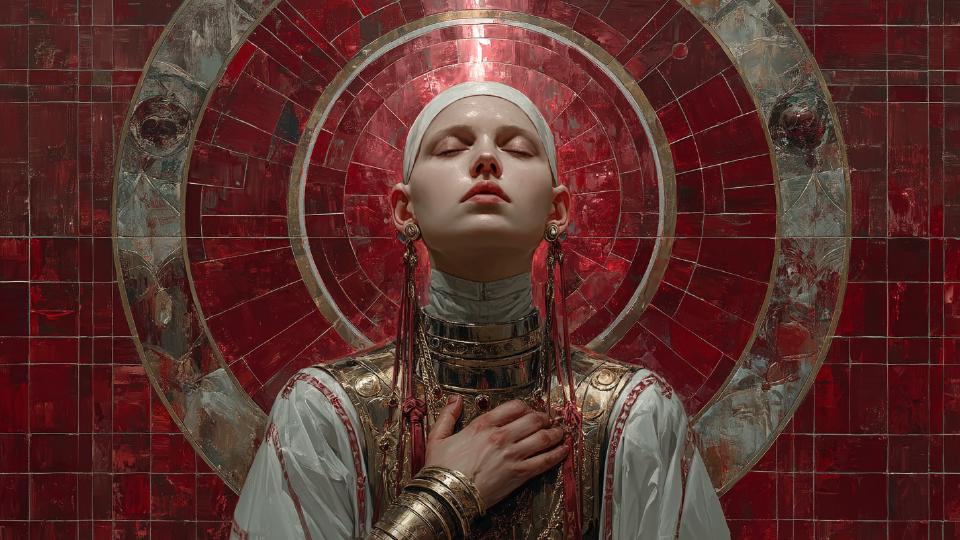
Prelude — The Pulse beneath the White Stone
Within the perfected whiteness of the Stone, a subtle vibration begins to stir. The once-cool brilliance thickens into warmth; light trembles as though touched by breath. What was static becomes rhythmic, the first pulse of the solar principle revealing itself. The rubedo is not a new creation but the quickening of what has been purified. Paracelsus named this the dawn of life eternal: when the Stone turns red, spirit and form unite through the medium of fire. The intellect ceases merely to reflect illumination and begins to embody it. Light must pass into flame.
This phase aligns with the classical operation of coagulation, the condensation of spirit within form. It marks the passage from reflection to vitality, from contemplation to incarnation.
The Guardian of Fire
As the solar current intensifies, it announces itself as ordeal. Within the visionary field, a fiery presence gathers: the Guardian of Fire. This is the final resistance of fear and separation before illumination attains sovereignty. In Hermetic and Chaldean doctrine, the Guardian stands at the threshold of noetic fire, the purifying flame of Nous, the divine intellect, as it descends into the soul’s image. In Neoplatonic philosophy, Nous is the self-thinking intellect and the generative light of all form. Plotinus and Proclus describe its fire as the creative energy through which divine Mind contemplates and sustains the universe. Thus, noetic fire is not material but intellectual, the radiant substance of thought refining its own vehicle.
This ordeal corresponds to calcination, the exposure of dense matter to the fire of awareness. The apparent adversary is inward: the latent will of the adept concentrated into form. The Guardian is not an opponent but a mirror, testing whether consciousness can bear the full heat of its own essence.
The Ordeal of Fire
The trial resolves through fearless assent. The adept recalls the Hermetic axiom, “fire consumes fire.” Entering the flame, the subtle body incandesces, shedding its veils one by one until only essence remains. This parallels the vision of Poimandres, where the ascending soul casts off the tunics of fire and receives divine flame in their stead. The Golden Chain of Homer describes the same dissolution, the death of the old form and the conception of the new within the blood of the Stone.
In alchemical terms this is dissolution, the refinement of consciousness through immersion in its own source. What once appeared as annihilation is revealed as liberation: fear itself transmuted into clarity. The Guardian fades into the radiance it once seemed to defend; individuality becomes transparent to the source from which it proceeds.
Immersion in the Philosopher’s Blood
The light liquefies into a deep red luminosity, the living fluid known to Hermetic writers as the sanguis philosophorum. It both dissolves and regenerates, the Menstruum Universale of Paracelsus, the seed-fluid of resurrection. The Golden Chain of Homer calls its cosmic archetype the universal sperm, the matrix of all rebirth. The two are sequential rather than identical: the sanguis philosophorum is the individual manifestation of the universal sperm, the microcosmic reflection of its generative essence. Immersion in this medium is the soul’s return to its life-principle.
This corresponds to putrefaction, the necessary dissolution of fixed identity before regeneration. The adept perceives no boundary between body and element; consciousness diffuses throughout the field like molten light. Death is seen to have been no more than a misapprehension of transformation.
The Adamantine or Diamond Body
From the crimson sea, new luminosity condenses into form. Geometry reasserts itself as the octahedron densifies toward cube and dodecahedron, earth and cosmos reconciled. The Stone becomes metallic and sun-bright.
Hermetic authorities call this the fixation of the Stone. The Hermetic Arcanum speaks of a body impervious to fire or decay; the Chaldean Oracles describe the soul arrayed in starry adamant. The Greek adamantinos conveys indestructibility, the perfect fusion of spirit and matter. Later synthesis, notably through vajra symbolism, introduced the term diamond body, emphasizing radiant indestructibility rather than mere hardness. Both signify the same attainment: density become transparency, light embodied without loss of purity.
This is the stage of fixation and perfected coagulation. The adept’s form is a crystalline vessel of solar energy, weightless yet impenetrable, each particle a self-luminous center.
The Solar Baptism
At this culmination, fire no longer descends from without; the heart itself burns as the lamp of Nous. This is the baptismus ignis, the fiery regeneration wherein Spirit and Soul unite to create the living Tincture, the force that renders all substance gold. The theurgic parallel is autexousion, the attainment of self-rule beyond the sway of fate: divine Mind acting consciously through human form.
In alchemical operation this corresponds to illumination or multiplication, the intensification of light within matter. The reflective lunar intelligence of albedo now becomes the creative solar agency of rubedo. Will and illumination coincide, and action itself becomes revelation.
Integration into the World
When equilibrium is restored, fire subsides into transparency. The perfected body remains tangible yet radiant, casting no shadow. Every gesture participates in the same transmuting harmony; the world answers as if tuned to the adept’s vibration.
This corresponds to the final operation, projection, the outward expression of the perfected Stone. The adept transforms by presence rather than effort; being itself becomes the act of transmutation.
Thus concludes the rubedo of the Lesser Stone: the reconciliation of purified intellect and pacified daimon, the fusion of spirit and form into living gold. This state, called synousia Theou, denotes conscious participation in divine Mind while embodied. Philosophically it parallels the Plotinian return to the One (Enneads VI.9), where the soul recognizes its unity with the source while retaining reflective awareness. Yet the Hermetic view diverges in its insistence on embodiment: the return is not withdrawal but irradiation, the One made visible through matter.
Such realization is balance, not conclusion; for in the Hermetic art, every perfection becomes the threshold of a greater fire.